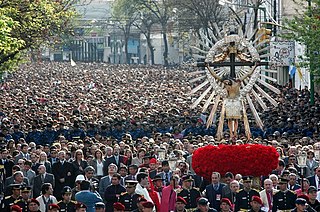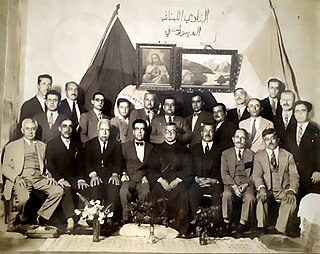
Christianity is the most widely professed religion in Argentina, with Roman Catholicism being its largest denomination. This historical background is very much due to the Spanish influence brought about through the newly conquered territories. However, affiliation with Protestant churches is increasing and immigration throughout the 20th century has brought other religions from various regions to Argentina.

Asian Argentines, are Argentine citizens or residents of Asian ancestry. The vast majority trace their ancestry to West Asia, primarily Lebanon and Syria, and East Asia, namely China and Japan. Though there are other communities of South Asian or Southeast Asian origin as well. Asian-Argentines settled in Argentina in large numbers during several waves of immigration in the twentieth century.

Arab Brazilians are Brazilian citizens of Arab ethnic, cultural, linguistic heritage and identity. The majority of Arab Brazilians trace their origin to the Levantine region of the Arab World, known in Arabic as Bilad al-Sham, primarily from Lebanon and Syria, as well as Palestine. Arab Brazilians are Christians in the great majority. The first Syrians and Lebanese arrived in São Paulo around 1880. It is not known exactly when, although the Syrians and Lebanese say that in 1885 there was a small core of peddlers working in the market square. By 1920, the census listed 50,246 Syrians and Lebanese in Brazil, 38.4% (2/5) of these in the state of São Paulo. The 1940 census enumerated 48,614 Syrians, Lebanese and other related groups with a decrease of approximately 1647 people. As immigration almost ceased after 1929 and the colony aged, it is surprising that the decline was not even greater. The trend of the period between 1920 and 1940 was the continuous concentration of Syrians and Lebanese in São Paulo. Almost half (49.3%) of Syrians and Lebanese residents in Brazil lived in São Paulo.

Argentina is a predominantly Christian country, with Islam being a minority religion. Due to secular nature of the Argentine constitution, Muslims are free to proselytize and build places of worship in the country.

Zulema Fátima Yoma was the First Lady of Argentina from 1989 until 1991, when she divorced President Carlos Menem.
Palestinian Nicaraguans are Nicaraguans of Palestinian ancestry who were born in or have immigrated to Nicaragua. They are part of the ethnic Arab diaspora.

Julio Daniel Asad is an Argentine former football player and manager. He played as a midfielder, and participated with Argentina in the 1975 Copa América.
Arab Colombians refers to Arab immigrants and their descendants in the Republic of Colombia. Most of the migrants came from Lebanon, Jordan, Syria and Palestine. When they were first processed in the ports of Colombia, they were classified as Turks because what is now Lebanon, Syria, Jordan and Palestine were then territories of the Ottoman Empire. It is estimated that Colombia has a Lebanese population of 3.2 million. Meanwhile the Palestine population is estimated between 100,000-120,000.
Omar Andrés Asad is an Argentine football manager and former player who played as a forward.
Arab Chileans are Chileans from predominantly Arab ancestry. People from the Arab world arrived in Chile as early as the mid-19th century. Historically, the Arabs of Chile were called Turks, Moors, Syrians, Lebanese, or Palestinians.

Diplomatic relations between the countries Argentina and Lebanon, have existed for over a century. Both nations enjoy friendly relations, the importance of which centers on the history of Lebanese immigration to Argentina. There are approximately 1.5 million Argentines of Lebanese descent. The Lebanese community in Argentina is the third largest immigrant community in the country and Argentina is host to the second largest community in Latin America. Both nations are members of the Group of 24 and the United Nations.
Arab Venezuelans refers to Venezuelan citizens of Arab origin or descent. There are around 1,600,000 Venezuelans of Arab origin, mainly from Lebanon, Syria and Palestine. Most Arab Venezuelans are of Syrian descent with their number between 400,000 and 1 million inhabitants, and Lebanese descent with their number between 341,000 and 500,000.
Arabs in Europe are people of Arab descent living in Europe today and over the centuries. Several million Arabs are residents in Europe. The vast majority form part of what is sometimes called the "Arab diaspora", i.e. ethnic Arabs or people descended from such living outside the Arab World. Most of the Arabs in Europe today are from the Maghreb.
Lebanese Colombians are Colombians of Lebanese descent. Most of the Lebanese community's forebears immigrated to Colombia from the Ottoman Empire in the late 19th and early 20th centuries for economic, political and religious reasons. The first Lebanese moved to Colombia in the late nineteenth century. There was another wave in the early twentieth century. It is estimated that over 10,000 Lebanese immigrated to Colombia from 1900 to 1930.
Lebanese Argentine refers to Argentine citizens of Lebanese descent or Lebanon-born people who reside in Argentina. Many of the Lebanese Argentines are descendants of immigrants cultural and linguistic heritage and/or identity, originating from what is now Lebanon.
A Lebanese Venezuelan is a Venezuelan citizen of Lebanese origin or descent. There are around 340,000 to 500,000 people of Lebanese ancestry.
Lebanese Chileans, are immigrants to Chile from Lebanon. Most are Christian and they arrived in Chile in the mid-19th to early-20th centuries to escape from poverty. Ethnically Lebanese Chileans are often called "Turks", a term believed to derive from the fact that they arrived from present day Lebanon, which at that time was occupied by the Ottoman Turkish Empire. Most arrived as members of the Eastern Orthodox church and the Maronite church, but became Roman Catholic. A minority are Muslim.
Syrian Argentines are Argentine citizens of Syrian descent or Syrian-born people who reside in Argentina. Argentina has the second highest number of Syrians in South America after Brazil. Syrian immigration to Argentina has been and is currently, one of the most important Arab migration flows into Argentina. Immigration waves peaked in the 20th century, although in recent years due to the constant wars in the Middle East, immigration from Syria has been increasing over time. Like other Arab Argentines, they are universally known as "turcos" ("Turks"), like in the rest of Latin American countries.

Turks in Mexico comprise Turkish people living in Mexico and their Mexico-born descendants. The Turkish community is largely made up of immigrants or the descendants of immigrants, born in the Ottoman Empire before 1923, in the Republic of Turkey since then or in neighbouring countries once part of the Ottoman Empire that still have some Turkish population.








